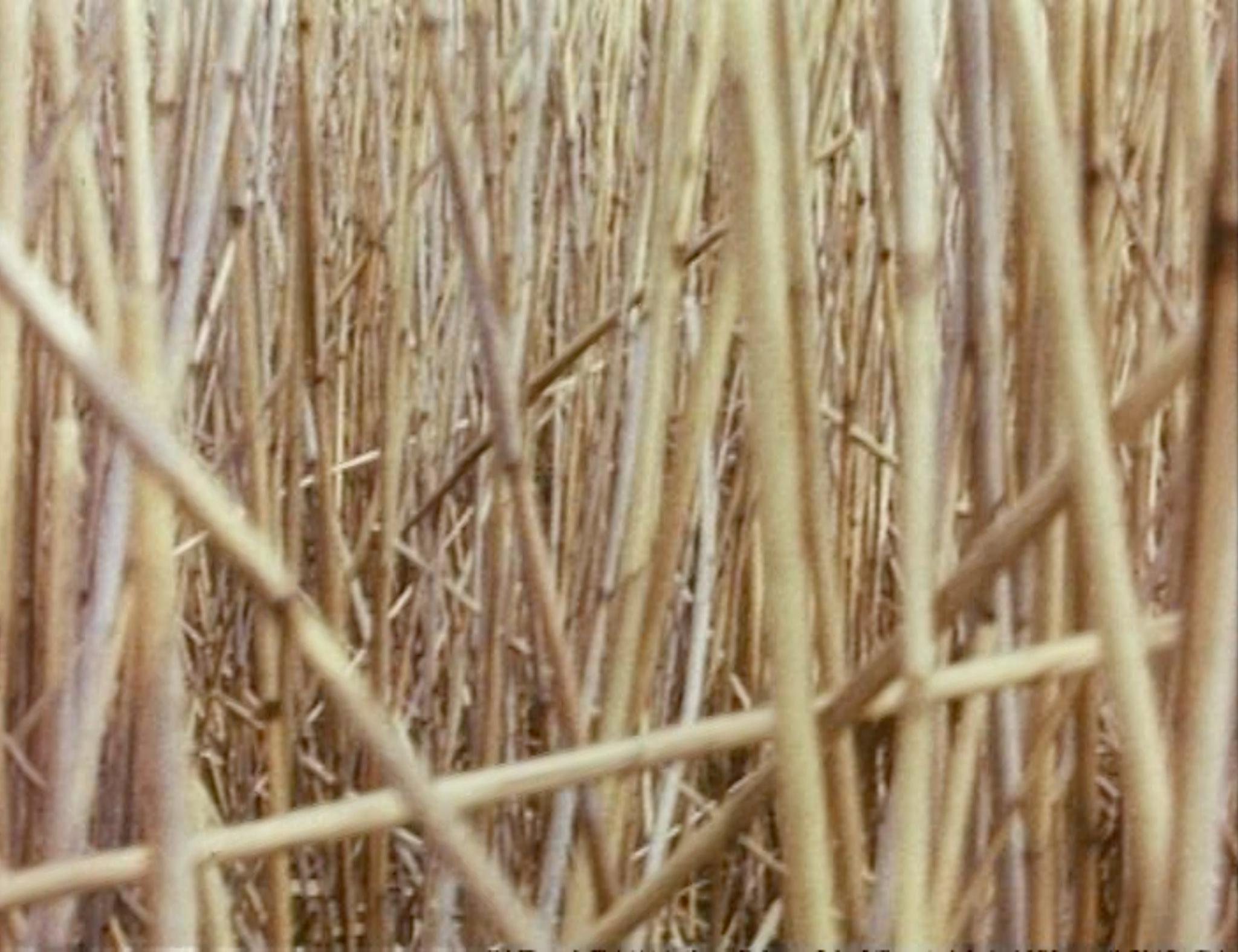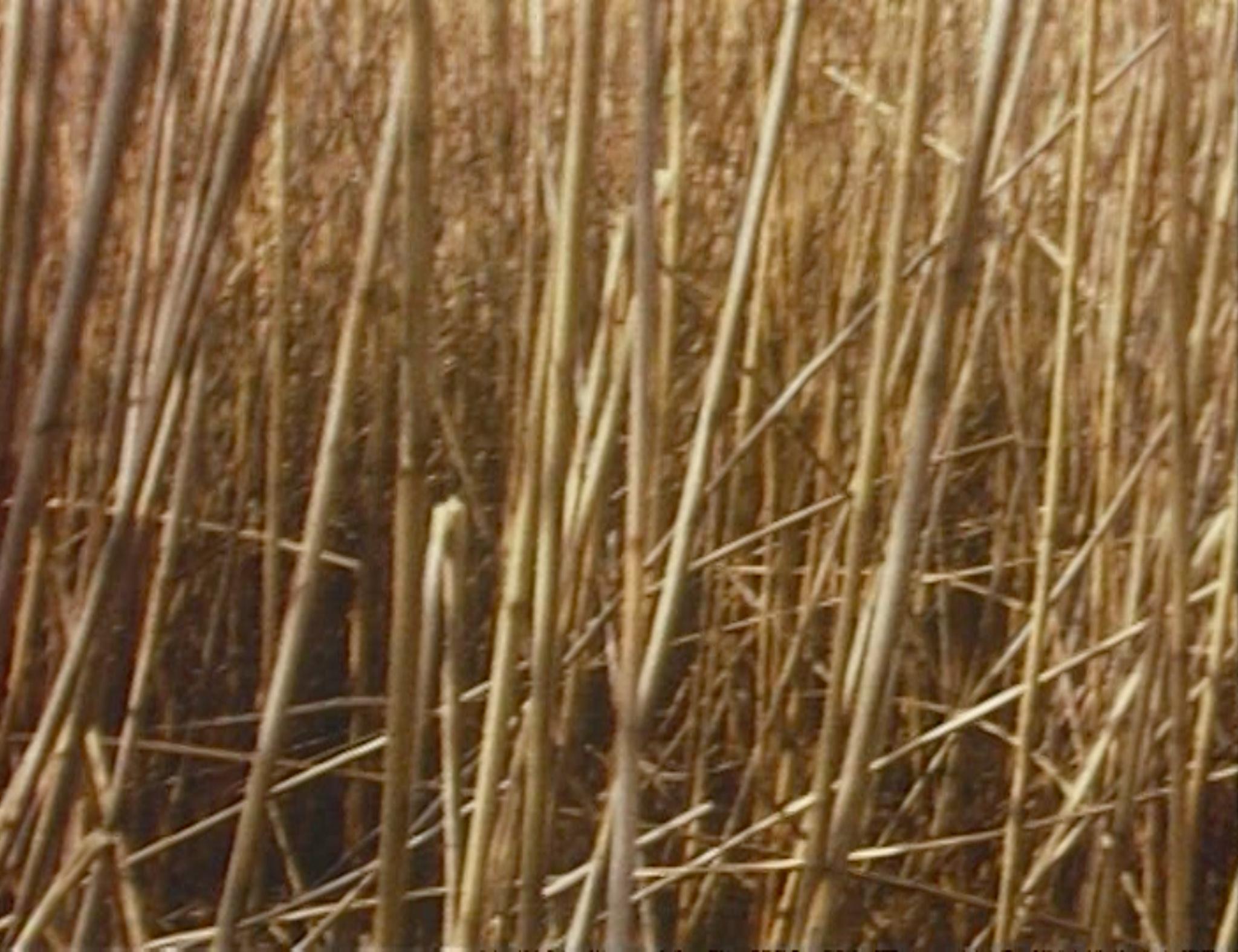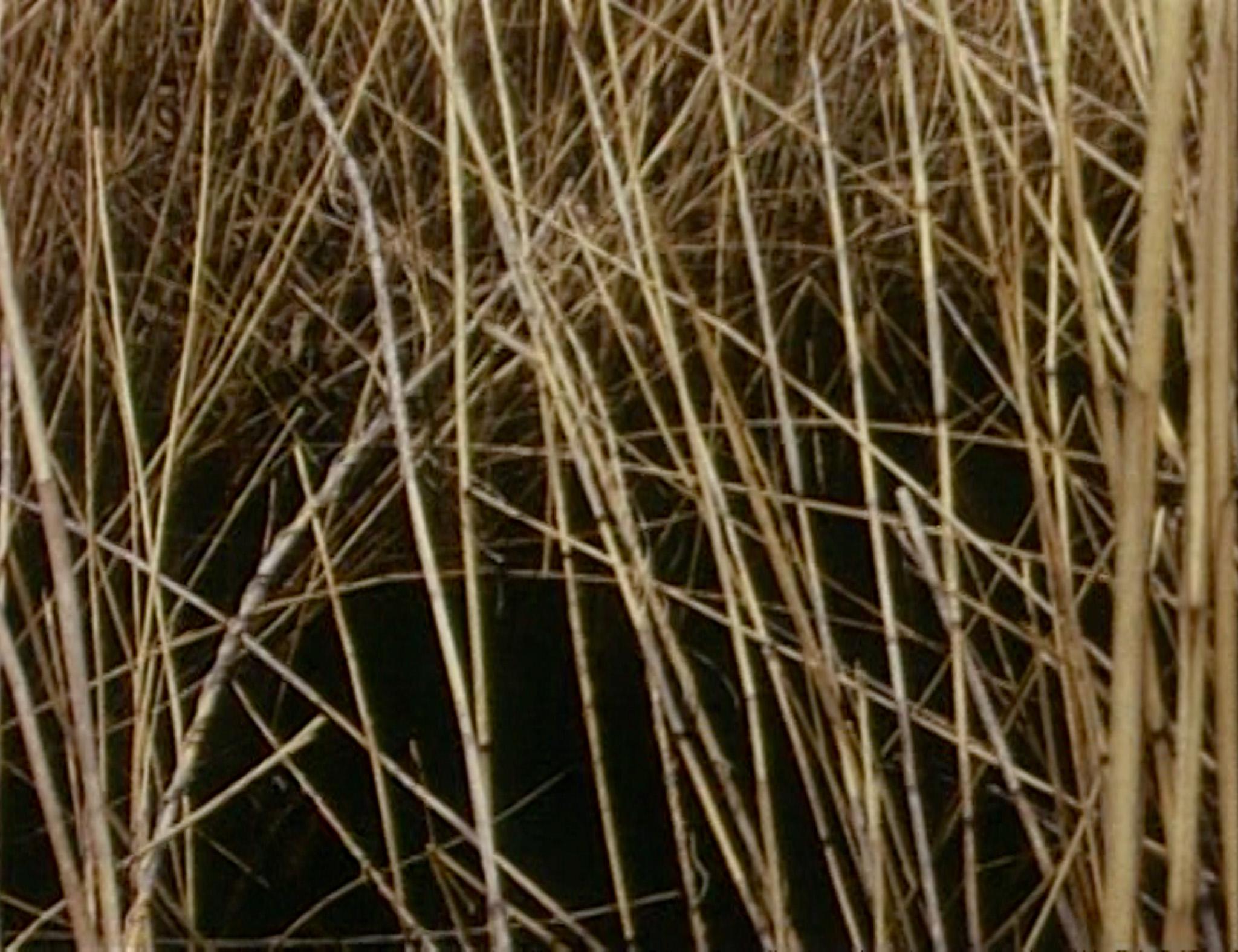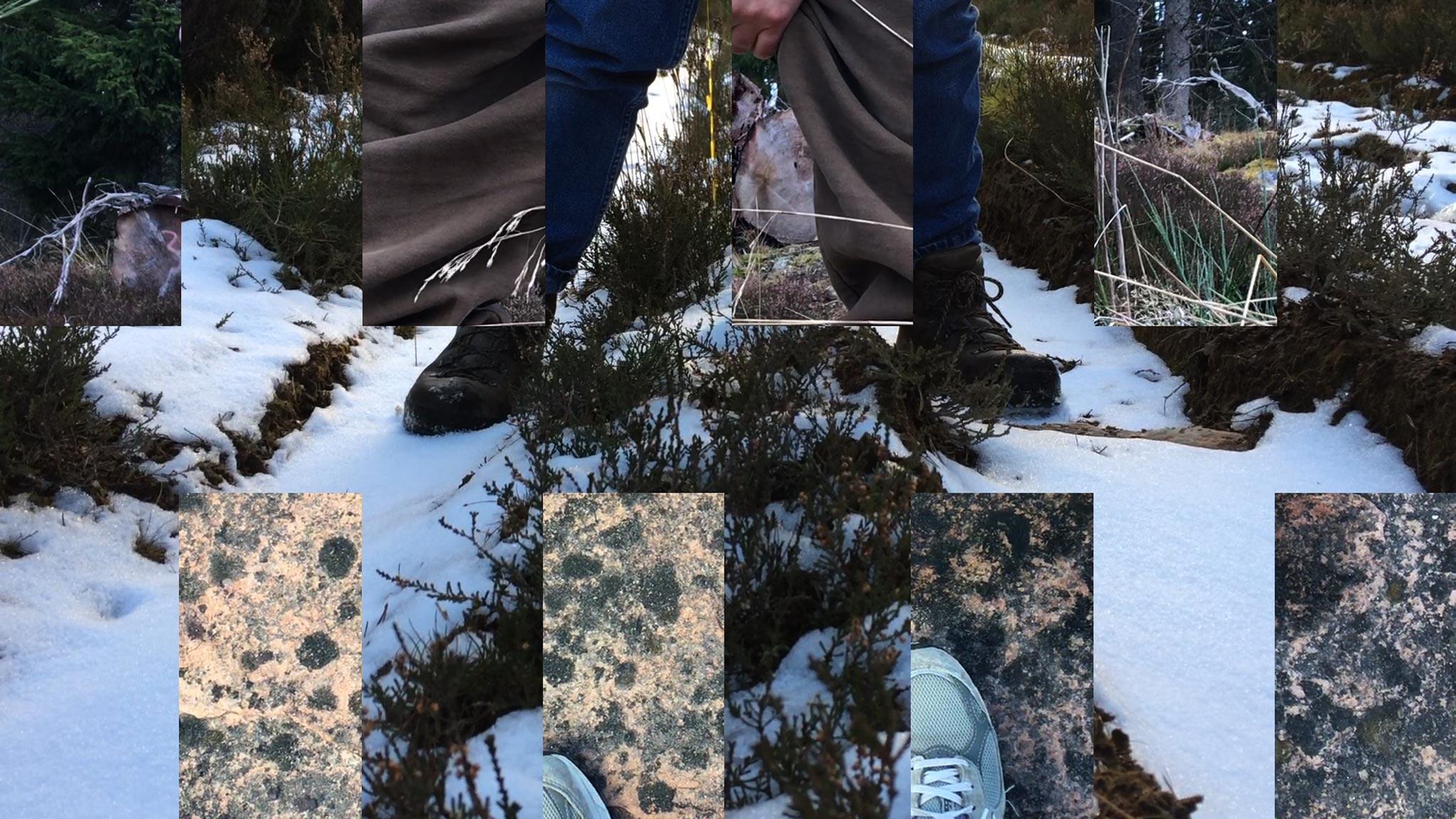Swampy Ecologies
You are in the middle of an expanse of tall thick dry grass, head height. As you look and move through this, a world unfurls that you become immersed in feeling, hearing, seeing, and experiencing fully in each moment. Expansive. The experience feels vivid and rich despite the difficulties of movement across uneven ground and against a fierce wind. Immersive. You cannot see beyond your immediate surroundings. There is no horizon. The world that emerges—step by step—feels intensely connected around you, almost thick, and you dissolve into it, into the grasses, into the terrain, into the wind that moves the grasses against your body. Sensory. Now imagine you have a camera, which you hold to your eye, this curtails your vision and concentrates it, because you can see only through the viewfinder. Perceptual. This has the strange effect of expansion and contraction at once. Focusing all your senses into this one intense portal limits the scope of your vision, while, at the same time, expanding to produce a world beyond sight. Feeling. Stumbling through this grassy meadow (or swamp) while trying to see without seeing, the almost violent sound of the wind whips around you and the dry crunch of your footsteps echo below. You feel the reeds cutting into your body as you brush past, and all sensation combines so that you experience an even more expansive sense of being, of being present.
Nancy Holt and Robert Smithson’s film, Swamp (1971; 16 mm film; 6 min, color, sound) dissolves perception into an expanded ecology of the image. We can understand this expanded ecology as the interweaving of constituent parts (visual and non-visual)—the shape of the terrain, the weather at that particular moment, the stamina of the body holding the camera, the materiality of the film to name a few. This ecology, which I will call “swampy”, can be understood along the lines of what the psychotherapist and philosopher Felix Guattari (1930-92) termed “eco-logic”—the movement of intensities that would allow things to emerge and dissolve.1 For Guattari, this emergence and dissolution occurs in relation to “three ecologies”, social, mental and environmental ecologies, which he loosely defines as how we see and navigate the world individually and collectively.2 I choose the term “swampy” to describe this relationship of bodies in the world because Holt and Smithson explore exactly this interconnectedness in Swamp, and in passages of their individual writings.
Shot in the New Jersey swamplands with a newly acquired Bolex camera, the basis of Swamp is straightforward—Holt shoots while Smithson directs her movement, recording his directions on a portable tape recorder while Holt tussles with the camera and difficult terrain. The film as such consists of a clearly defined temporal and spatial frame: the passage across the dry swamp, the length of the film reel. Holt has said of the film that it “deals with the limitations of perception through the camera eye…”3 as she reflected on her own sightless condition while filming. Her vision was limited to what was afforded by the viewfinder of the camera, what Holt elsewhere calls “camera-vision.”4 I would suggest, however, that Swamp deals with both expansion and limitation at once, expressed through both an intensity and intensely embodied experience of being-present and the expansion of the sensory world through that experience.
Holt’s concrete poem, The World Through a Circle (ca.1970) articulates this intensity of focus very clearly while, at the same time, situating it within a particular time and place. She writes: “The world through a circle / … / Concentrated, encompassed / The sky brought down / A hole through the earth”. And later, “The world focusses / And spins out again / Seen.”5 The poem raises questions of time, of the spatio-temporal as well as bodily relation to earth, and to the process of being and being present that both refers to the camera (“the circle”) and the intensity of experience that we find in the film. The World Through a Circle thus provides a possible diagram, or map, for understanding Swamp. On the one hand, the poem pinpoints a defined set of limitations and, on the other, the movement beyond these (and back again). Here, we might also think of what Smithson has referred to as an “abstract cartography”, which can be understood as a series of defined, ordered points that act as departures towards other wild possibilities.6 In Swamp, there is a beginning and end point marked by the duration of the film reel and the topography of the swamp–beyond that is the present, which is empty of time, empty of thought, and without destination. Smithson’s “abstract geology” is present here too in the ecology of processes and intensities that we find in Swamp, produced through the “erosion” of the boundaries between the mind and body and the earth.7
The erosion of boundaries that Smithson evokes in his essay “A Sedimentation of the Mind”—outside of the limits of thought, outside the limits of the individual body and towards a greater interconnectedness with climate, land and so on—can be related in a very different way to the collaborative project of filming Swamp. It’s tempting to read Swamp in the context of both Holt and Smithson’s interest in language, and in relation to the prevalence of “instruction pieces” at the time.8 But, we can also think of Holt and Smithson’s collaboration in making Swamp as another mode of extending the capacities of their individual bodies so that the film emerges–polyphonically–from somewhere between the artists, the camera, the material structure of the filmstrip, the difficulties of the terrain, the stickers and the wind. This is not a smooth process, it is a communication full of gaps and errors as Smithson instructs “Turn to your right” and Holt somehow always turns left, as Smithson says go “towards the puddle over there” and Holt, “I can’t see anything”. Holt’s misinterpretations and resistances to Smithson’s directions combined with Smithson’s lack of knowledge about the mechanics of filming (confusing the squint with remaining length of film), undoes a straightforward reading of the gendered power dynamics at play here–Smithson directing Holt. Rather the gaps, misunderstandings, resistances and unevenesses between Holt and Smithson as well as the land, climate and other conditions all combine and contribute to the expanded–swampy–ecology of the film that ensues.
Thinking about the broad participations in Swamp—the working together of bodies, camera, climatic conditions and so on (a swampy ecology of sorts)—I return to thinking of Holt carrying the camera, held to the eye. Here there is sense of an image that is embodied, inhabited, and produced through the closure of the gap between body (eye) and apparatus (camera). What ensues from this is always a process with rather than for the camera, a process that remakes the limitations of both camera and eye. I find something of this methodology in the work of contemporary artists, such as Charlotte Prodger (b. 1974), for the way in which the camera becomes an extension of and beyond the body—an embodied witness of being in the world yet also a set of limitations to move with and through. We see this, for example, in the opening sequence of the film, Bridgit (2016; 32 minutes; color, stereo, HD Video) in which the artist situates the camera on her chest, and it looks down along her prone body. The camera moves gently as the body breathes; it is a collaboration that produces a very particular image for here is a body present, embodied yet filmed as if geologic contours; it is at once both the map and its abstraction, the cosmos and a defined set of limits.9
Swamp is an immersive (swampy) film. It is a film without an outside, and without a horizon, save for the end of the film reel itself. Smithson directs Holt to keep the camera low and “shoot into the density of it. (…) Don’t want too much sky,” he says. This produces a sense of a constantly unfolding present-moment as well as a sense of being-with and inside the film itself, in the swamp. Holt has said of filming: “…all you could see is what I see. I had the camera-vision, all I could see is what I could see through the camera.”10 And watching Swamp, I too attempt to navigate through a New Jersey swamp; the reeds move against my body, my face as I stumble and the image shakes uncertainly. And it is as if I am immersed in the processes of an unfolding world—in an image that is formed through a messy, mutual relationship (a collaboration) between reeds, camera, artists, light, length of film, terrain, wind. It is a swampy ecology of parts—of bodies, of perceptions, technologies and materials entwined. And so, Swamp is also an expansive film. It expands through the disintegration of singular forms into textures, movements and flows. It is a map of a bodily relation to the processes of being present in the world that go beyond the “turbidity of thinking” towards an intensity of sensory and extra-sensory experience into and outside of the world.11 And “the world focusses” momentarily before it “spins out again. / Seen.”12
Selected Bibliography
Guattari, Felix, “The Three Ecologies”, new formations Number 8, Summer 1989, p.136
Holt, Nancy, The World Through a Circle (ca. 1970), https://holtsmithsonfoundation.org/world-through-circle Last accessed May, 29 2020
Holt, Nancy and Smithson, Robert, Swamp (1971), https://www.eai.org/titles/swamp Last accessed May, 29 2020
Holt, Nancy, “Nancy Holt introduces Swamp at EAI on Wednesday, November 15, 2006”, https://www.eai.org/titles/swamp/video-intro Last accessed May, 29 2020
Smithson, Robert, “A Museum of Language in the Vicinity of Art” (1968), Robert Smithson: Collected Writings, edited by Jack Flam, University of California Press: Berkeley, Los Angeles, London, 1996, p.92
Smithson, Robert, “A Sedimentation of the Mind: Earth Projects” (1968), Robert Smithson: Collected Writings, edited by Jack Flam, University of California Press: Berkeley, Los Angeles, London, 1996, p.100
About the Author
Dr Bridget Crone (1973-2023) was an internationally recognized curator, writer, and Senior Lecturer in Visual Cultures at Goldsmiths, the University of London. Bridget’s work concerns forms of encounter between bodies, time and the image in contemporary art practice as well as broader theoretical contexts. In 2022, shortly before her untimely death, she published the co-edited volume Fieldwork for Future Ecologies: Radical Practice for Art and Art-Based Research.
- 1Guattari, Felix, “The Three Ecologies”, new formations NUMBER 8 SUMMER 1989, p.136
- 2Guattari, Felix, “The Three Ecologies”, p.134
- 3Description of film on the website of Electronic Arts Intermix, provided by Nancy Holt, eai.org
- 4Nancy Holt introducing Swamp at Electronic Arts Intermix, New York, November 15, 2006
- 5Holt, Nancy, The World Through a Circle, ca. 1970
- 6Smithson, Robert, “A Museum of Language in the Vicinity of Art” (1968), Robert Smithson: Collected Writings, edited by Jack Flam, University of California Press: Berkeley, Los Angeles, London, 1996, p.92
- 7Smithson, Robert, “A Sedimentation of the Mind: Earth Projects” (1968), Robert Smithson: Collected Writings, edited by Jack Flam, University of California Press: Berkeley, Los Angeles, London, 1996, p.100
- 8Smithson, for example, contributed to Lucy Lippard’s exhibition project, 955,000 (Vancouver, 1970) in which artists sent instructions for their works to be performed / produced, rather than the art object itself. We could also think of Smithson’s instructions as something acting as a kind of “abstract cartography”, as was mentioned earlier, that is, as an already fallible from which to deport towards greater–wilder possibilities.
- 9Charlotte Prodger’s film LHB 2017 (20 minutes, color, sound, HD Digital) make reference to Swamp in its opening sequence, which involves the artist crashing through thick expanses of gorse bushes. This transposes Swamp to a Scottish location, a site local to the artist, while addressing a similarly immersive cinematic cartography – a cartography that ensues through the body and its relation to the world. LHB closes the gap between eye and camera, such that the body and camera become intertwined; as traces of fingers or thumb remain on the image, we are reminded that the body is never at a remove in Prodger’s embodied filming practice.
- 10Nancy Holt introducing Swamp at Electronic Arts Intermix, New York, November 15, 2006
- 11Smithson, Robert, “A Sedimentation of the Mind: Earth Projects” (1968), Robert Smithson: Collected Writings, edited by Jack Flam, University of California Press: Berkeley, Los Angeles, London, 1996, p.100
- 12Holt, The World Through a Circle, ca. 1970
Crone, Bridget. "Swampy Ecologies." Holt/Smithson Foundation: Scholarly Texts Chapter 1 (May 2020). https://holtsmithsonfoundation.org/swampy-ecologies




